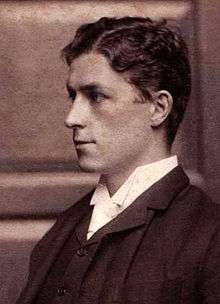Arthur Llewelyn Davies
| Arthur Llewelyn Davies | |
|---|---|
 Davies in 1890 | |
| Born |
February 20, 1863 Kirkby Lonsdale |
| Died |
19 April 1907 (aged 44) London |
| Alma mater | Trinity College, Cambridge |
| Occupation | barrister |
| Spouse(s) |
Sylvia du Maurier (1892-1907, his death) |
| Children | 5 sons |
Arthur Llewelyn Davies (20 February 1863 – 19 April 1907) was a barrister, but is best known as the father of the boys who were the inspiration for the stories of Peter Pan by J. M. Barrie.
Biography
Davies was the second son of Mary Crompton and the Reverend John Llewelyn Davies, Vicar of Kirkby Lonsdale. His father was a fellow of Trinity College, Cambridge, an early alpinist who was the first ascendant of the third highest mountain in the Alps, and an outspoken foe of poverty and inequality who was active in Christian Socialist groups.[1][2] Arthur attended Marlborough College and Trinity College, Cambridge.[3] He was briefly a Master at Eton College, but left that position to practice law. His sister was suffragist Margaret Llewelyn Davies.[4]

He met Sylvia du Maurier (daughter of cartoonist George du Maurier and sister of future actor Gerald du Maurier) at a dinner party in 1889 and they became engaged shortly thereafter.[5] He married her in 1892, and they had five children, all boys: George (1893–1915), Jack (1894–1959), Peter (1897–1960), Michael (1900–1921), and Nicholas (1903–1980).
In 1897, his pre-school sons George and Jack became friends with Barrie, whom they met during outings in Kensington Gardens with their nurse Mary Hodgson and their infant brother Peter. Davies and his wife Sylvia met Barrie and his wife Mary at a New Year's Eve dinner party that year, and she took up a close friendship with the writer as well. Although Davies did not encourage the ongoing friendship of his wife and sons with Barrie, and did not share their fondness for him, he did little to stand in the way of it. He permitted Barrie to spend considerable time at the Davies home, and for his family to visit with the Barries – who were childless – at their country cottage. During one of the holidays the families spent together, Barrie took a series of photographs of the boys' adventures, which he compiled into a photo book titled The Boy Castaways; Barrie gave one of the two copies printed to Davies, who misplaced his copy on a train.[6]
Barrie's novel The Little White Bird, which featured episodes about a boy ranging up to his son George's age, whose mother resembled Sylvia, both befriended by a thinly disguised version of Barrie, was published in 1901. Barrie's play Peter Pan, or the Boy Who Wouldn't Grow Up, which the playwright repeatedly said was inspired by Davies' boys, debuted in December 1904. The chapters of The Little White Bird featuring Peter Pan were republished in 1906 as Peter Pan in Kensington Gardens, with the dedication "To Sylvia and Arthur Llewelyn Davies and their boys (my boys)".
In 1904, the year when Barrie's play debuted, Davies moved with his family out of London when they purchased Egerton House, an Elizabethan mansion house in Berkhamsted, Hertfordshire.[7] In 1906, Davies discovered a growth in his cheek which turned out to be a malignant sarcoma. He had two operations, which removed much of his upper jaw, palate, and cheekbone, and the tear duct on that side. This left him disfigured and unable to talk, even with an artificial jaw insert, but failed to remove all of the cancer and left him in considerable pain. Barrie, who had become wealthy from his books and plays, paid for Davies's medical care, and became a regular companion at his bedside, especially in his final months. During this time, Davies described Barrie in a letter to his son Peter as "a very good friend to all of us". Family accounts differ on just how close the two actually became. Davies died at Egerton on 19 April 1907, at the age of 44.[5]
Portrayals
In the 1978 BBC mini-series The Lost Boys, he was portrayed by Tim Pigott-Smith.
He did not appear in the 2004 film, or in the 2015 Broadway musical Finding Neverland about Sylvia and Barrie's relationship and the writing of Peter Pan. In the film and the musical, he was said to have already died when Barrie entered the family's life, but in fact was alive for most the events depicted. Removing him from the events of the movie simplified the plot, and avoided the subject of Barrie's impact on the Davies' marriage.
References
- ↑ Obituary of John Llewelyn Davies, The Times, Friday, May 19, 1916
- ↑ Scott, Gillian (1998). Feminism and the politics of working women : the Women's Co-operative Guild, 1880s to the Second World War. London: UCL Press. ISBN 1857287983.
- ↑ "Davies, Arthur Llewelyn (DVS881AL)". A Cambridge Alumni Database. University of Cambridge.
- ↑ http://www.co-op.ac.uk/politicalwomen/cs2.html
- 1 2 Birkin, Andrew, J. M. Barrie and the Lost Boys.
- ↑ Chaney, Lisa. Hide-and-Seek with Angels - A Life of J. M. Barrie, London: Arrow Books, 2005
- ↑ Hastie, Scott (1999). Berkhamsted: an Illustrated History. King's Langley: Alpine Press. p. 63. ISBN 0-9528631-1-1.
External links
-
 Works written by or about Arthur Llewelyn Davies at Wikisource
Works written by or about Arthur Llewelyn Davies at Wikisource